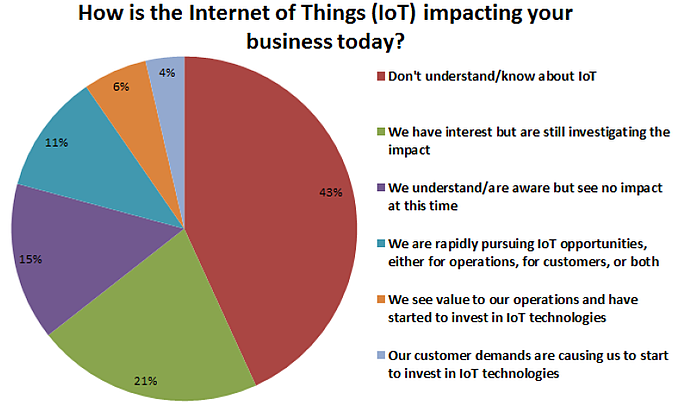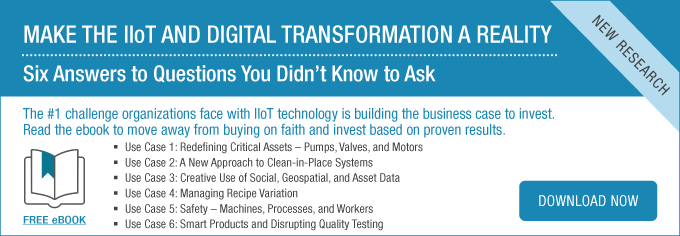According to Cisco, there will be 13.5 billion connected devices in manufacturing by 2022. And JP Morgan’s Global Equity Research team has already pegged manufacturing with having the greatest Internet of Things (IoT) market potential. Although it’s difficult to accurately gauge the impact these technologies will have, it’s clear that experts are projecting it to be massive.
But what do manufacturing leaders have to say about the IoT?
Several months ago, we launched some new IoT survey questions that dig a little deeper into this topic. The study asks manufacturing executives and other senior leaders how the IoT is impacting their business today, as well as about their expected IoT investments going forward. What’s interesting is that almost half—43%—of these industry professionals indicated they still “don’t understand” or “know about” the IoT.
Given the hype around the IoT, these numbers may seem a bit odd to some. But the emerging technologies have the potential to be broadly disruptive, making the potential applications appear daunting for many businesses, therefore this trend is likely to continue until after more proven and commonplace solutions surface in the coming years—and they will.
In this post, we’ll drill down into this new IoT research data and share insights into what you should do if you fall into the “don’t understand” category.
Attitudes toward IoT in Manufacturing
Although the number of respondents stating they “don’t understand” the IoT is substantial, almost 300 different individuals (and counting) have responded to these survey questions and this particular question offered seven options.

A combined 42% acknowledged having an interest in or understanding of the IoT. 1 in 5 reported being interested in but still investigating the impact. And 11% are rapidly pursuing IoT opportunities either internally, with customers, or in both regards. There seems to be somewhat of a split between executives who are learning about and experimenting with the IoT compared to those who don’t understand the technology.
Why Should You “Know About” the IoT
The IoT is expected to transform the way businesses operate. We’re already seeing use cases surface in manufacturing as well as in the consumer world, particularly with the servitization of products—in other words, enabling new service models whereby customer buy or rent a delivered result from a product instead of the product itself. And in the near future we’re expecting to see more use of intelligent sensors and devices in the shop floor environment, providing enormous amounts of new data streams that can be utilized up and down the value chain. Massively parallel and in memory big data analytics technologies which are considered part of the IoT are expected to provide insights into real-time performance, from which correlations can be drawn that were previously too resource-intensive to calculate.
The utility of the IoT may be as vast as your imagination, but here are a few potential connected device use cases for perspective:
- Quality Intelligence: Adding new quality variables and more precise data into real-time production monitoring and statistical process control to anticipate process variations
- Asset Management: Adding new variables for monitoring machine performance, predicting failures, and alerting workers
- Health and Safety: Equipping staff with connected wearables that monitor key health and safety indicators like body temperature or exposure to hazardous elements
- Service: Gaining visibility into real-time product performance and diagnostics without having to rely on traditional on-site field service techniques
- Sustainability: Closely monitoring the usage of utilities such as water, air, gas, or steam with wireless intelligent gauges that offer remote information access
The idea behind nearly all IoT applications is to gather new, more finite types of information and data and then transform it into usable, contextualized intelligence, awareness, and collaboration. Capturing all of this data will likely prove to be the easier part, while making the data work for you will be a bit more challenging. Algorithms and predictive analytics are key, along with intelligent workflow and communications that support situational awareness, and software vendors in numerous categories are working on providing these capabilities.
It’s only a matter of time before more widespread adoption takes place and real-time performance monitoring and value chain collaboration really gets taken to the next generation.
Preparing Yourself for the Revolution
As is the case with any new technology, there tends to be different phases in the adoption lifecycle. And, given the IoT’s relative nascency—not to mention the manufacturing sector’s traditionally slow-to-deploy mentality—these “don’t understand” numbers are not all that shocking. We expect to see them shift more toward having an understanding and using the technology in the coming years, especially with the parallel and aggressive consumerization of the technology happening.
Additionally, on the manufacturing side of things, a number of new organizations are helping expedite this shift. These include Industrial IP Advantage and the Industrial Internet Consortium (IIC), which involve large players like Cisco, Panduit, Rockwell Automation, AT&T, Cisco, GE, IBM, and Intel. These organizations are working on the development of security best practices, and new standards and semantic models to facilitate communication between intelligent devices and support intelligent systems.
The base of interest in the IoT seems to be strong, but the question is how do you bridge that gap from not knowing about the IoT to actually being a user? There are a few things you can do today:
- Educate Yourself: Start reading case studies, research papers, and articles focused on the IoT. There are many theoretical resources available, but as the technology matures it’s important to look for resources that incorporate the use of IoT-generated data as a means for validation.
- Start Experimenting: The IoT may seem like futuristic technology, but there are in fact many connected devices being used in the manufacturing sector already today. From connected thermostats to connected machines and more, there are opportunities to start experimenting.
- Get Involved: As mentioned, there is still much work to be done in terms of things like standards and protocols for the IoT. Professionals are coming together in a variety of ways to accelerate the technology’s maturity and capability.
- Consider Training: With the next generation of manufacturing technology already having a foot in the door, many leading companies are considering how they can take advantage of professional training to provide their workers with the competencies and skills needed to compete into the future.
